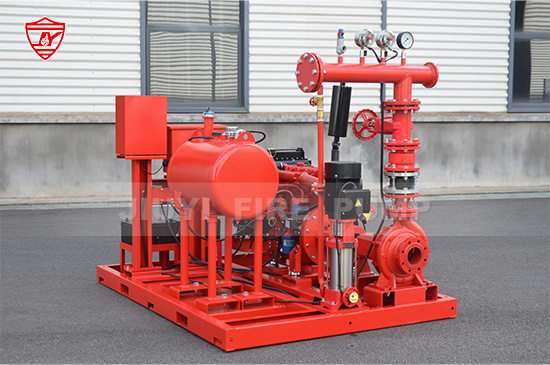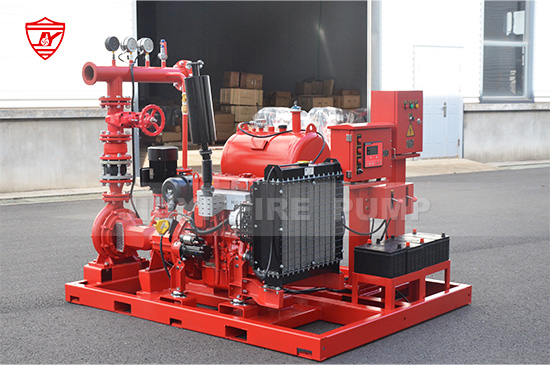In a fire emergency, every second matters. The ability of a fire pump to start automatically when water pressure drops can be the difference between a minor incident and a catastrophic loss. That’s why testing the fire pump auto-start function is crucial to any fire protection system maintenance program.
In this guide, we’ll walk you through the importance, methods, and best practices for testing the auto-start function of fire pumps—whether electric or diesel-driven—following NFPA 20 guidelines and industry standards.

A fire pump is designed to activate automatically when the system detects a drop in water pressure, typically caused by the opening of a sprinkler head or fire hydrant valve. The auto-start function ensures the pump engages immediately—without human intervention—so water flow can reach critical points at the required pressure.
To understand how to test the auto-start feature, it’s important to know what components are involved:
Pressure sensing line: Detects pressure changes in the system.
Pressure sensing switch or transducer: Sends a signal to the fire pump controller when the pressure falls below the preset threshold.
Fire pump controller: Receives the signal and commands the pump to start automatically.
Jockey pump: Maintains system pressure during normal conditions to prevent unnecessary pump starts.
The combination of these components allows the fire pump to respond automatically to system demands.
Failing to test auto-start features regularly can lead to serious system failures when they’re needed most. Some common risks of neglecting this test include:
Delayed response time during a fire event.
Electrical or control system failures remaining undetected.
Mechanical failures that prevent the pump from starting.
Non-compliance with fire protection codes like NFPA 20 and NFPA 25.
Regular testing ensures that your fire pump system is not only functional but also compliant with international fire safety standards.
According to NFPA 25 (Inspection, Testing, and Maintenance of Water-Based Fire Protection Systems), the automatic start function of fire pumps must be tested weekly. This test verifies that the pump will start automatically upon a pressure drop and that all components involved in the process function correctly.
NFPA 20 (Standard for the Installation of Stationary Pumps for Fire Protection) provides the guidelines for how the system should be designed and wired to enable automatic start, ensuring reliable performance.
Below is a step-by-step guide for conducting a proper fire pump auto-start test in accordance with industry standards.
Before starting:
Notify relevant personnel such as facility management and safety officers.
Ensure discharge valves are open to prevent damage.
Record current system pressure as a reference point.
Check fuel level (for diesel pumps) or power source (for electric pumps).
Confirm that the jockey pump is operational and maintaining normal system pressure.
Safety is paramount—so always ensure the system is ready to handle the pressure and flow changes that will occur.
The auto-start function relies on a drop in pressure to activate the pump. To test this, you can:
Slowly open a test valve or drain valve downstream of the system to release water, reducing pressure.
Observe the pressure gauge until it falls below the start pressure setting (typically 10 psi below the jockey pump stop pressure).
As soon as the pressure drops below the threshold, the fire pump should start automatically.
Once the fire pump starts:
Verify that the controller receives the signal from the pressure switch.
Check for smooth pump operation — no unusual noise, vibration, or pressure surges.
Observe the time delay between pressure drop and pump start; it should be within the expected range (usually a few seconds).
For diesel fire pumps, confirm that the engine cranks and runs smoothly, with stable oil pressure and exhaust condition.
Record the exact start time and compare it with previous test data to detect any deviations.
Once the pump is running:
Observe the pressure rise in the discharge line.
Check the flowmeter (if installed) to confirm water is moving as expected.
For electric pumps, monitor amperage and voltage to ensure the motor is operating within normal limits.
For diesel pumps, note the RPM, oil pressure, and coolant temperature.
These readings help identify potential problems before they lead to system failure.
The controller is the brain of the system. During the test:
Confirm that status indicators on the controller show “Auto Start” or “Running.”
Check for any fault alarms such as low voltage, phase loss, or start failure.
Make sure manual start and stop functions also work correctly.
If the controller fails to respond, it may indicate wiring issues, faulty pressure switches, or a malfunctioning control board.
After confirming the pump has successfully auto-started:
Gradually close the test valve to restore pressure.
Stop the pump manually or allow it to stop automatically (depending on system setup).
Verify that the jockey pump resumes normal operation and maintains pressure.
Record all test results in the fire pump maintenance log.
This documentation is important for both regulatory compliance and future troubleshooting.
Regular tests often uncover hidden issues that can compromise system performance:
Pressure switch miscalibration leading to delayed starts.
Controller faults preventing automatic engagement.
Air leaks in sensing lines that cause false starts.
Jockey pump malfunction creating unnecessary fire pump activations.
Electrical relay or wiring damage from corrosion or age.
Identifying and fixing these problems early ensures the fire pump remains reliable in an actual emergency.
To maintain system integrity and compliance, consider these best practices:
Test weekly as per NFPA 25.
Rotate personnel so multiple technicians are trained on the procedure.
Use calibrated gauges to ensure accurate readings.
Document every test with date, results, and observations.
Include both automatic and manual start tests in your maintenance schedule.
Conduct annual flow tests to verify overall system performance.
Consistent testing not only improves reliability but also extends the lifespan of the pump and control system.
Safety should always come first:
Never perform tests when firefighting systems are needed for active protection.
Use proper personal protective equipment (PPE).
Keep discharge points clear of people or obstacles.
Avoid rapid valve closures to prevent pressure surges or water hammer.
Always have an emergency shutdown procedure in place.
Testing may seem routine, but mishandling high-pressure water systems can lead to injury or equipment damage.

Testing the fire pump auto-start function is a simple yet critical process that ensures your fire protection system will respond instantly when needed. Whether your system uses an electric or diesel fire pump, verifying automatic operation each week according to NFPA 25 keeps your facility compliant, safe, and prepared for emergencies.